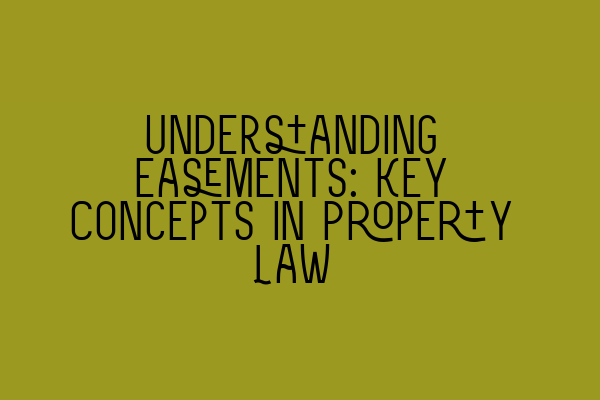Understanding Easements: Key Concepts in Property Law
As experienced property law solicitors at SQE Property Law & Land Law, we understand the importance of having a strong foundation in the key concepts of property law. One such concept that often arises in property transactions is easements. In this blog post, we will provide you with a comprehensive understanding of easements, covering their definition, types, creation, and termination.
What is an Easement?
An easement is a legal right that allows one person (the dominant owner) to use another person’s land (the servient land) for a specific purpose. It grants the dominant owner a non-possessory interest in the servient land, which remains with the servient owner. Easements are commonly created to grant rights of access, utilities, or light.
Types of Easements
There are several types of easements that can be created depending on the specific needs and agreements of the parties involved. Some of the most common types of easements include:
1. Right of Way: This type of easement grants the dominant owner the right to pass through the servient land. Right of way easements are often created to provide access to landlocked properties or to establish a pathway between two parcels of land.
2. Easement for Utilities: This type of easement allows utility companies to access the servient land for the purpose of installing, maintaining, and repairing utility lines, such as water pipes or electrical cables.
3. Easement for Light and Air: These easements protect and guarantee the dominant owner’s right to receive a specific amount of light or air through the servient land, typically by prohibiting the servient owner from obstructing the view or building structures that may block the light or air.
4. Easement of Support: This type of easement ensures that the dominant owner’s land is supported by the servient land. It commonly arises in situations where one adjoining property relies on the support of another.
How are Easements Created?
Easements can be created in various ways, including by express grant, by implied grant, by necessity, and by prescription.
1. Express Grant: An easement can be created by an express grant, which involves the dominant owner granting the easement rights to the servient owner through a written agreement.
2. Implied Grant: In some cases, an easement may be implied by the circumstances or previous conduct of the parties involved. This could occur when there is a long-standing usage of a certain portion of the servient land by the dominant owner.
3. Easement of Necessity: An easement of necessity can be created when a property is landlocked, meaning it has no direct access to a public road. In such cases, a court may grant an easement of necessity to ensure that the landlocked property has a means of access.
4. Easement by Prescription: An easement by prescription can arise when the dominant owner openly and continuously uses the servient land for a statutory period of time (commonly 20 years or more). If the usage meets the legal requirements, the dominant owner may acquire an easement by prescription.
Termination of Easements
Easements can be terminated in several ways, including by express release, by merger, by abandonment, by prescription, or by operation of law. It is important to understand the specific circumstances that may lead to the termination of an easement to ensure compliance with the law.
In conclusion, understanding the key concepts of easements is essential in property law. Whether you are a property owner, a prospective buyer, or a legal professional, having a clear understanding of easements will enable you to navigate property transactions smoothly and ensure the protection of your rights and interests.
If you are studying for the SQE 1 or SQE 2 exams, we highly recommend checking out our related articles for further preparation and exam tips. You can find SQE 1 practice exam questions here. To access SQE 1 practice mocks FLK1 FLK2, click here. We also offer comprehensive SQE 2 preparation courses that can help you excel in your exams. Learn more here. For those planning to take the SQE 1 exams, we have tailored preparation courses available. Discover more about our SQE 1 preparation courses here. Finally, make sure to keep track of the SRA SQE exam dates here.
Remember, having a solid understanding of easements and other key concepts in property law is crucial for success in the legal field. If you require legal advice or assistance with any property-related matters, do not hesitate to reach out to SQE Property Law & Land Law. Our team of experienced solicitors is ready to provide you with expert guidance and support.
